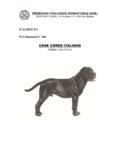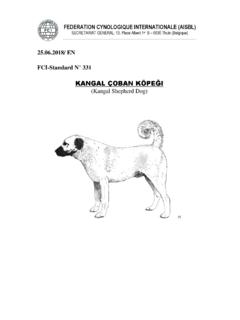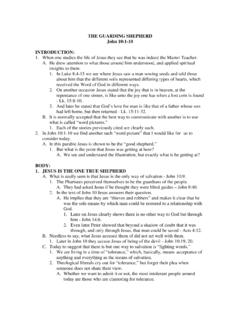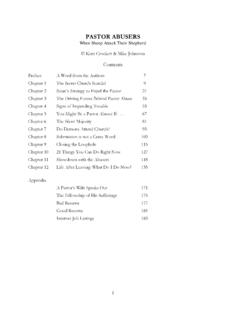Transcription of 331g02-en - Fédération Cynologique Internationale
1 FEDERATION Cynologique Internationale (AISBL). SECRETARIAT GENERAL: 13, Place Albert 1er B 6530 Thuin (Belgique). _____. EN. FCI-Standard N 331. KANGAL OBAN K PE I. (Kangal shepherd Dog). 2. ORIGIN: Turkey. DATE OF PUBLICATION OF THE OFFICIAL VALID. STANDARD: UTILIZATION: shepherd Dog used for guarding sheep . Active breed originally used as a guard dog for sheep ; hard working;. capable of enduring extremes of heat and cold. FCI-CLASSIFICATION: Group 2 Pinscher and Schnauzer . Molossoid breeds Swiss Mountain and Cattle Dogs. Section Molossoid breeds, Mountain type. Without working trial. BRIEF HISTORICAL SUMMARY: Although each nation eagerly designates a breed history for their national breeds, rarely is it possible to come up with an accurate one, especially when it comes to livestock protection dogs.
2 The Kangal Dog's history is also one of them. However, it is a breed deeply imbedded in today's Turkish culture. It is Turkey's highly praised National Dog. It wouldn't be too unrealistic to say that the Turkish people migrating from Central Asia whose livelihood primarily relied on nomadic animal husbandry brought their strong livestock protection dogs along with them. It is a well-known fact that the dogs protecting sheep and goats in Central Asia are of various colours. The question regarding the origins of the Kangal Dog we know today should be about what caused them to have a more unifying standard in terms of type and especially colour in Turkey. It is believed that lies with the area they are highly populated in Eastern Turkey and the kind of sheep breed they are known to protect: Akkaraman sheep .
3 FCI-St. N 331 / 3. They both seem to share the same black mask on a dun coloured coat across the vast steppes of Eastern Turkey surrounded by high mountains, creating relatively an isolated population. This suggests a perfect camouflage and adaptation for both. The breed name, Kangal seems to come from the town of Kangal off Sivas where the breed attracted worldwide attention with exceptionally high quality and uniform specimens. GENERAL APPEARANCE: Large, upstanding, powerfully built, livestock guarding dog with dark mask. Not aggressive but good guardian. Capable of great speed. The Kangal is a molossus type dog. Its constitution is robust. Compact body is covered with thick and medium length of hair. Body is of rectangular shape. IMPORTANT PROPORTIONS: Profile lines of the muzzle and the skull are divergent.
4 Body length is 10-12% longer than height at the withers. Depth of chest is approximately 50% of height at the withers. BEHAVIOUR/TEMPERAMENT: Steady and bold without aggression, naturally independent, very intelligent and tractable. Proud and confident. Loyal and affectionate to owners, but wary of strangers when on duty. HEAD. CRANIAL REGION: Large, but in proportion to the body. Skull: Broad between ears, slightly narrowing toward the stop. Slightly rounded. Length of the skull is greater than width of the skull. Stop: Slight. FACIAL REGION: Nose: Black. Muzzle: Shorter than the skull. Muzzle length is 40-44% of head length. Profile blunt, tapering slightly to the end. Muzzle line from stop towards the nose is gently sloped. FCI-St. N 331 / 4. Lips: Very slightly pendulous, black-edged.
5 Edge of upper lip not lower than the profile of the underjaw. Corner of mouth tight. Jaws/Teeth: Teeth strong, scissor bite is prefered, level or reverse scissor bite accepted, lack of P1 and M3 not to be penalized. Cheeks: Well muscled, cheek bones are visible but not pronounced. Eyes: Almond shaped medium to large, size in proportion to size of skull, set well apart, showing no haw. Dark brown to light brown, the darker, the better. Eye rims black. Ears: Medium sized, triangular in shape, rounded at tip, pendant with front edge close to cheek, higher when alert. Cropped ears (where allowed) are evaluated as the non-cropped ones. NECK: Slightly arched, powerful, muscular, length is almost equal to length of head, rather thick. Can have very slight dewlap. Neck is not carried in upright position.
6 BODY: Powerful, well muscled, never flat in the sides. Top line: Slightly arched over loins. Croup a bit higher than height at the withers. Withers: Powerful, slightly prominent. Back: Medium length, strong, well muscled Loin: Slightly arched. Croup: Of medium length. Muscular, well connected to the loins. Sloping at almost 30 degrees. Chest: Deep, reaching the point of the elbows, ribs well sprung, ribcage sufficiently long. Underline and belly: Belly slightly tucked up. TAIL: Long, reaching a bit under the hock, Upper line of the tail forms a continuous line with the croup line when relaxed carried low with close curl at the tip; when alert carried high and curled over the back, specially on males. FCI-St. N 331 / 5. LIMBS. FOREQUARTERS: General appearance: Set well apart, straight and well boned; of good length.
7 Shoulder: Well muscled, oblique. Upper arm: Must be muscular and strong. Close to the body. Elbow: Close to the sides but allowing free movement. Forearm: Harmonic length with body, strong boned, straight. Carpus (Wrist): Strong. Metacarpus (Pastern): Strong, slightly sloping when viewed from the side. Forefeet: Strong, with thick pads and well arched toes. Nails short and preferably black. HINDQUARTERS: General appearance: Powerful, not overloaded with muscles. Hind legs vertical when seen from behind. Thigh: Long Stifle (Knee): Well angulated. Lower thigh: Muscular, strong. Hock joint: Firm, wide. Moderate angulation. Metatarsus (Rear pastern): Well developed, moderate length and stands vertical to the ground. Parallel to each other. Hind feet: Strong, with thick pads and well arched toes.
8 Nails short and preferably black. Presence of dewclaws is accepted. GAIT / MOVEMENT: Very noticeable, line of head, neck and body at the same level when walking, movement even, supple and long reaching, giving impression of stalking, with great power. Pacing acceptable at slow speed. SKIN: Of medium thickness, well adhering to the head and body. Slight dewlap is tolerated. Skin colour depends on hair colour, but skin must be pigmented. FCI-St. N 331 / 6. COAT: Hair: 3 to 7 cm, thick and harsh guard coat, dense undercoat. Length variations in coat may be possible according to weather conditions. Longer and thicker on neck, shoulders and thighs. COLOUR: Whole body should be one colour. Can be from fawn to wolf sable. White or lighter colour on chest is not considered as a fault if is not larger than 10 cm of width.
9 White colour on throat is not preferred. White colour on paws and feet can be seen. Less white is preferred. Must have black mask. Mask covers the muzzle and it is lighter on the skull. Ears are dark. It can be a dark line on half or one third of tail from tip to base. White tip on tail is accepted. SIZE AND WEIGHT: Height at the withers: Males: 72 to 78 cm. with + /- 2 cm of tolerance Females: 65 to 73 cm. with +/-2 cm of tolerance Weight: Males: 48 to 60 kg Females: 40 to 50 kg FAULTS: Any departure from the foregoing points should be considered a fault and the seriousness with which the fault should be regarded should be in exact proportion to its degree and its effect upon the health and welfare of the dog. SEVERE FAULTS: Skull wider than its length from occiput to stop.
10 Lower croup height than height at the withers. Too light or too heavy construction for working condition. Untypical tail shape. FCI-St. N 331 / 7. White patch on the neck. White line on the muzzle and mask. DISQUALIFYING FAULTS: Aggressive or overly shy dogs. Any dog clearly showing physical or behavioural abnormalities shall be disqualified. Untypical specimen. Overshot bite. Undershot exceeding reverse scissors bite. Muzzle too short (one third of the total length of the head). Coat very short and smooth, devoid of undercoat. No mask on muzzle. Brown nose and pigmentation. Different coloured eyes. : Male animals should have two apparently normal testicles fully descended into the scrotum. Only functionally and clinically healthy dogs, with breed typical conformation, should be used for breeding.









